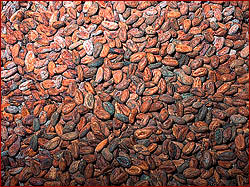![]()
|
Caffeine is the most well known of these chemical ingredients, and while it's present in chocolate, it can only be found in small quantities. Theobromine, a weak stimulant, is also present, in slightly higher amounts. The combination of these two chemicals (and possibly others) may provide the "lift" that chocolate eaters experience. |
|
|
|
Researcher Daniele Piomelli explains why his group decided to study chocolate. |
Phenylethylamine is also found in chocolate. It's related to amphetamines, which are strong stimulants. All of these stimulants increase the activity of neurotransmitters (brain chemicals) in parts of the brain that control our ability to pay attention and stay alert.
|
|
Daniele Piomelli discusses the pharmacological differences between chocolate and THC . |
|
While stimulants contribute to a temporary sense of well-being, there are other chemicals and other theories as to why chocolate makes us feel good. Perhaps the most controversial findings come from researchers at the Neurosciences Institute in San Diego, California. They believe that "chocolate contains pharmacologically active substances that have the same effect on the brain as marijuana, and that these chemicals may be responsible for certain drug-induced psychoses associated with chocolate craving." We talked to Emmanuelle diTomaso, who worked on the original study in San Diego (she's now a researcher at Harvard), and to Daniel Piomelli, who heads the project and continues to do research at the Neurosciences Institute.
 How
does this work? Brain cells have a receptor for THC (tetrahydrocannabinol),
which is the active ingredient in marijuana. A receptor is a structure
on the surface of a cell that can lock onto certain molecules, making
it possible to carry a signal through the cell wall. (diTomaso described
it as a "lock-and-key" system.) "The active compound," she told me, "will
lock itself to the protein on the membrane of the cell, and that triggers
a reaction inside the cell." In the case of THC, that chemical reaction
is what would make someone feel "high."
How
does this work? Brain cells have a receptor for THC (tetrahydrocannabinol),
which is the active ingredient in marijuana. A receptor is a structure
on the surface of a cell that can lock onto certain molecules, making
it possible to carry a signal through the cell wall. (diTomaso described
it as a "lock-and-key" system.) "The active compound," she told me, "will
lock itself to the protein on the membrane of the cell, and that triggers
a reaction inside the cell." In the case of THC, that chemical reaction
is what would make someone feel "high."
 THC,
however, is not found in chocolate. Instead, another chemical, a neurotransmitter
called anandamide, has been isolated in chocolate. Interestingly, anandamide
is also produced naturally in the brain. Both diTomaso and Piomelli went
to great lengths to explain that this finding doesn't mean that eating
chocolate will get you high, but rather that there are compounds in chocolate
that may be associated with the good feeling that chocolate consumption
provides.
THC,
however, is not found in chocolate. Instead, another chemical, a neurotransmitter
called anandamide, has been isolated in chocolate. Interestingly, anandamide
is also produced naturally in the brain. Both diTomaso and Piomelli went
to great lengths to explain that this finding doesn't mean that eating
chocolate will get you high, but rather that there are compounds in chocolate
that may be associated with the good feeling that chocolate consumption
provides.
Still, the research results made for great newspaper headlines. In 1996, when Piomelli's first study was published and "picked up" by the press, he received a number a phone calls and visits from representatives of the major chocolate companies. "They were worried," he said, "that they would have to put a warning from the Surgeon General on their products."
|
|
|
Daniele Piomelli explains how "anandamide" works in the brain and how chocolate consumption may affect us. |
Anandamide, like other neurotransmitters, is broken down quickly after it's produced. Piomelli and his team found other chemicals in chocolate which may inhibit the natural breakdown of anadamide. This means that natural anandamide (or introduced anandamide) may stick around longer, making us feel good longer, when we eat chocolate.
More research needs to be done to understand the effects of chocolate on the brain, and Piomelli's group is currently working on a new study that should be published next year. In the meantime, I'm going to be doing a few experiments of my own. Now that I know more about the captivating confection, I guess I'm going to have to start sampling all the different types and brands of chocolate at my local candy store--one by one.
|
|
 One
of the most pleasant effects of eating chocolate is the "good feeling"
that many people experience after indulging. Chocolate contains
more than 300 known chemicals. Scientists have been working on isolating
specific chemicals and chemical combinations which may explain some
of the pleasurable effects of consuming chocolate.
One
of the most pleasant effects of eating chocolate is the "good feeling"
that many people experience after indulging. Chocolate contains
more than 300 known chemicals. Scientists have been working on isolating
specific chemicals and chemical combinations which may explain some
of the pleasurable effects of consuming chocolate.